|
 |
The Memotech MTX Series |
 |
MEMOTECH DISK UPGRADE
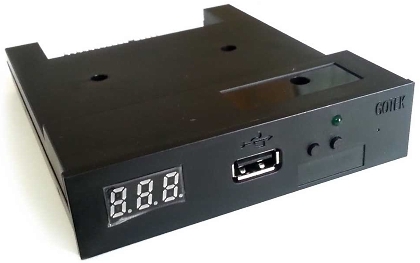

This is a work in progress -
to be continued . . . .
Background
The floppy disk drives and media used in the
original MTX disk systems are becoming increasingly unreliable
and no longer suitable for day-to-day use. Although there are a
number of modern day alternatives available, such as my
CFX systems (Compact Flash) and Andy Key's
REMEMOrizer (SD Card), legacy Memotech disk based systems
really need drop-in replacement disk drives.
I have had good results using both internal and
external
HxC floppy disk replacement devices, but they are not cheap
and cost more than many MTX'ers are prepared to pay. However,
there is an alternative . . . .
The image at the top of this page shows a floppy
disk drive emulator, I think it was originally designed by
Gotek in India. These drives
were designed to replace the 3.5" 720k/1.44MB drives found in
PCs, industrial machines, music synthesiers, etc. and are
readily available from eBay and the like, typically costing
between £12 and £20 (as of March 2018). The firmware supplied
with the drives is locked down and provides only basic PC type
compatibility. Around 2014,
Hervé
Messinger developed replacement firmware that allowed the
Gotek to be used in a Commodore Amiga. The firmware was released
into the public domain and soon started to appear loaded onto
Gotek hardware on eBay and various retro computer sites in
contravention of Hervé's stipulation on his site that the
firmware should not be installed on pre-flashed devices. Unfortunately, this led
to Hervé ceasing to develop his firmware. Since then though,
others have developed replacement firmware to allow the emulator
to replace floppy disks in other retro computers, including the
Atari ST; Jean-François Del Nero has even released a commercial
version of his HxC firmware than runs on the Gotek (the license cost
is 10 Euros).
More recently, Keir Fraser has developed another
firmware solution, described in his
Project History on GutHub: "The FlashFloppy project was
begun as a Free and Open Source replacement for the abandoned
free Cortex firmware. . . My aim then was to implement a more
capable Gotek firmware, . . . compatible with a wide range of
host systems." After lying dormant for a couple of years, Keir's
project kicked off in earnest in mid 2017 and at the time of
writing (March 2018) has progressed to the point where the
firmware is capable of supporting many Shugart compatible drives
and is compatible with disk image formats such as RAW and even
HFE (the HxC format).
| |
|
In addition
to supporting the basic interface of the standard Gotek device,
including a 2 or 3 digit hex display and Up/Down
buttons, FlashFloppy also supports a range of additional
hardware modifications, including an LCD or OLED display, a
rotary encoder for scrolling the selected image and an piezo sounder to emulate disk stepping.
An
example of a "fully loaded" FlashFloppy device is used
as the
Flash-Floppy Facebook Group photo. |
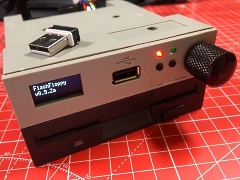 |
I bought a
Gotek from a Chinese supplier on eBay UK for £12.05
(March 2018). To match the Memotech hardware, I opted
for a black one.
This photo is from the eBay
listing, as you can see, this unit includes a 3 digit
hex display but I will be replacing it with an OLED
display. |
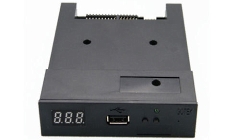 |
| It seems
that the OLED most commonly used is a 0.91" (128x32) display,
so I bought one of these from AliExpress for £1.75. The
FlashFloppy firmware allows the usable display area to
be restricted to the size of the Gotek display cutout,
this will be neater than trying to enlarge the cutout. |
 |
I bought 5
of these piezo beepers from an eBay UK vendor for £2.89
They have short lengths of wire attached, but for
connection to the Gotek header pins, I spliced on
additional wires terminated with Dupont connectors. |
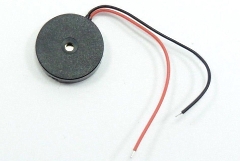 |
A bare
rotary encoder can be used, but the most common
implementation seems to be to use a KY040 module which
has an attached PCB.
They are plentiful and
cheap on eBay, I bought a pack of 6 from another
Chinese eBay UK vendor costing £2.61. |
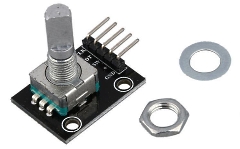 |
| The FDX
used 5.25" drives, so I purchased a 3.5" to 5.25"
adapter from another Chinese eBay UK vendor costing
£2.12 |
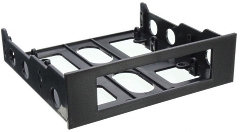 |
The PCB
removed from the case.
The jumper positions at
the top left (J3/J4) and centre bottom (JK) are shipped
without pins installed. These need to be populated to
facilitate connection of the ancillaries and to allow a
jumper to be fitted when flashing the firmware. |
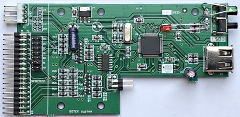 |
With the
jumpers installed.
Jumper "JK" will be inside the
Gotek case, fitting an angled jumper, like the existing
"J7" jumpers is the best option. |
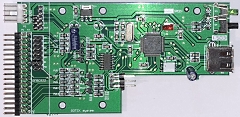 |
With the
jumpers installed (although, some people just use a bit
of wire jammed in the holes!), the firmware can be
upgraded using the ST Microelectronics
DfuSe program. (The software can be freely
downloaded, but you need to register on the ST
Microelectronics site.)
Instructions for flashing
the Gotek firmware can be found on the
FF Wiki. You can program it serially using a USB-TTL
adapter, but the easiest method is to use USB
programming, this requires a USB A-A cable.
The
procedure is well
described in this video. |
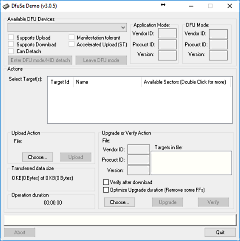 |
At this point, I
wanted to test the basic Gotek without any of the
additional hardware modifications, so, with the firmware
upgraded to the latest version of FlashFloppy (at the
time of writing, v0.9.16a), I connected the Gotek to an
FDX.
With the Gotek pinned for drive ID0 and FDX
drive 0 set to Memotech Type 03 (DS/DD, 40 Tracks) I
copied one of my existing HxC "hfe" Type 03 system disk
images to the root directory of a blank USB stick and
powered on the FDX. The system quite happily booted from
the Gotek without any problems.
I copied a second
disk image to the USB stick and was able to switch
between them using the "Up" / "Down" buttons. The
3-digit display is adequate when there are only a few
image files on the USB stick; when selecting a different
image, the buttons are used to scroll between the
images, when the required image number is displayed and
the buttons are released, the display briefly flashed to
show that a new image has been selected.
Hosts
such as the Amiga and Atari ST have navigator software
available that allows the disk images to be selected
from an onscreen menu. For these machine, the 3-digit
display may be sufficient, but for the MTX, it is not
adequate, so an LCD or OLED display is a must.
The next step was to try my OLD display. |
The
connections for the OLED display can be found on the
FF Wiki page. (Image courtesy of Keir Fraser)
Again, connecting my OLED display worked first time. |
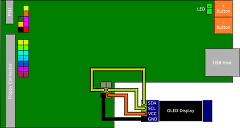 |
| I tested
the display before I mounted it and the text is very
clear (even with the protective film still on the
display). Although only 0.91" wide, the display is more
than adequate. |
 |
| |
|
| The encoder
PCB is really a little too big for the Gotek case. I
removed the encoder of the board so that it would sit
nicely in the front panel. There was a pilot "dimple" in
the cover which was in the perfect place for the encoder
knob to be fixed and drilled through that point with a
7mm bit. |
 |
The
connections for the encoder can be found on the
FF Wiki page. (Image courtesy of Keir Fraser)
I removed the PCB and soldered wires directly to the
terminals , the other ends had Dupont connectors fitted
for attaching to the pin headers on the Gotek PCB. |
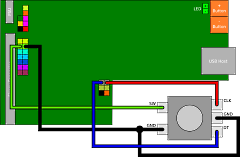 |
| |
|
| |
|
At this point, I was
able to read/write the Gotek with my FDX using the .hfe
image files that I created with the HxC software for use
with my HxC emulators. I think that I probably have most
of the available MTX software in .hfe images but I also
wanted to have the Gotek work with the raw image files
that Andy Key's .mfloppy format uses.
FlashFloppy
natively supports a wide range of image formats,
including, Atari ST, Amstrad CPC and Acorn
DFS/ADFS. It has pre-configured track layouts for some
Raw Sector images, such as various music samplers, so I
thought that adding Memotech formats should be
relatively straight forward.
After providing
details of the Memotech disk formats and Andy's .mfloppy
images, Keir kindly added support for Memotech Type 03
and 07 images. Although FlashFloppy can handle longer
file extentions, it works best with 3 characters and .img
follows existing FlashFloppy naming conventions so we
agreed that Memotech images would use this naming
convention.
This is slightly awkward in that it
means renaming Andy's .mfloppy file names, but this can
be easily done in Windows using PowerShell. For example,
to rename all of the files in the current directory, you
can use the PowerShell command line :
Dir | Rename-Item –NewName { $_.name
–replace ".mfloppy-07","-07.img" }
This renames files in the form
filename.mfloppy-07 to
filename-07.img
I copied all of
Andy's .mfloppy files in both Type 03 and Type 07 to the
USB thumb drive, but in practice, only the single set of
files that correspond to the FDX/SDX disk controller
configuration are required. In most circumstances, you
will want to configure the disk controller for an 80
track drive and use the Type 07 image files. In that
case, you could also remove the format type from the
filenames.
|
Here we
are, testing the Gotek with the firmware upgraded to
support .mfloppy type images as well as the "standard"
HxC .hfe images.
The floppy drive emulator is
connected to an FDX with the disk type configured for a
DS/DD 80 Track drive. The FlashFloppy window shows the
name of the currently loaded image - in this case,
"SuperCalc_07" - my original SuperCalc disk, converted
to a Type 07 .hfe image file. |
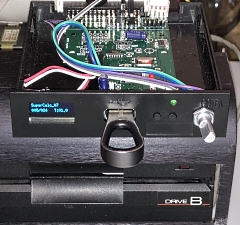 |
At this point, the
Gotek appeared to be working, it could read both Type 03
and Type 07 image files and I thought that I had found a
nice replacement for Memotech floppy disk drives at much
lower cost than using HxC devices.
However, when
I started to use the device more extensively to backup
my existing Memotech disk and image libraries, I found
that I experienced occasional write and formatting
errors with the image files on the USB pen drive.
|
| |
|
| |
|
| Cost
breakdown |
| Gotek |
£12.05 |
| Display |
£0.91 |
| Encoder |
£0.44 |
| Beeper |
£0.58 |
| Adapter |
£2.12 |
| Firmware |
Free ! |
|
|